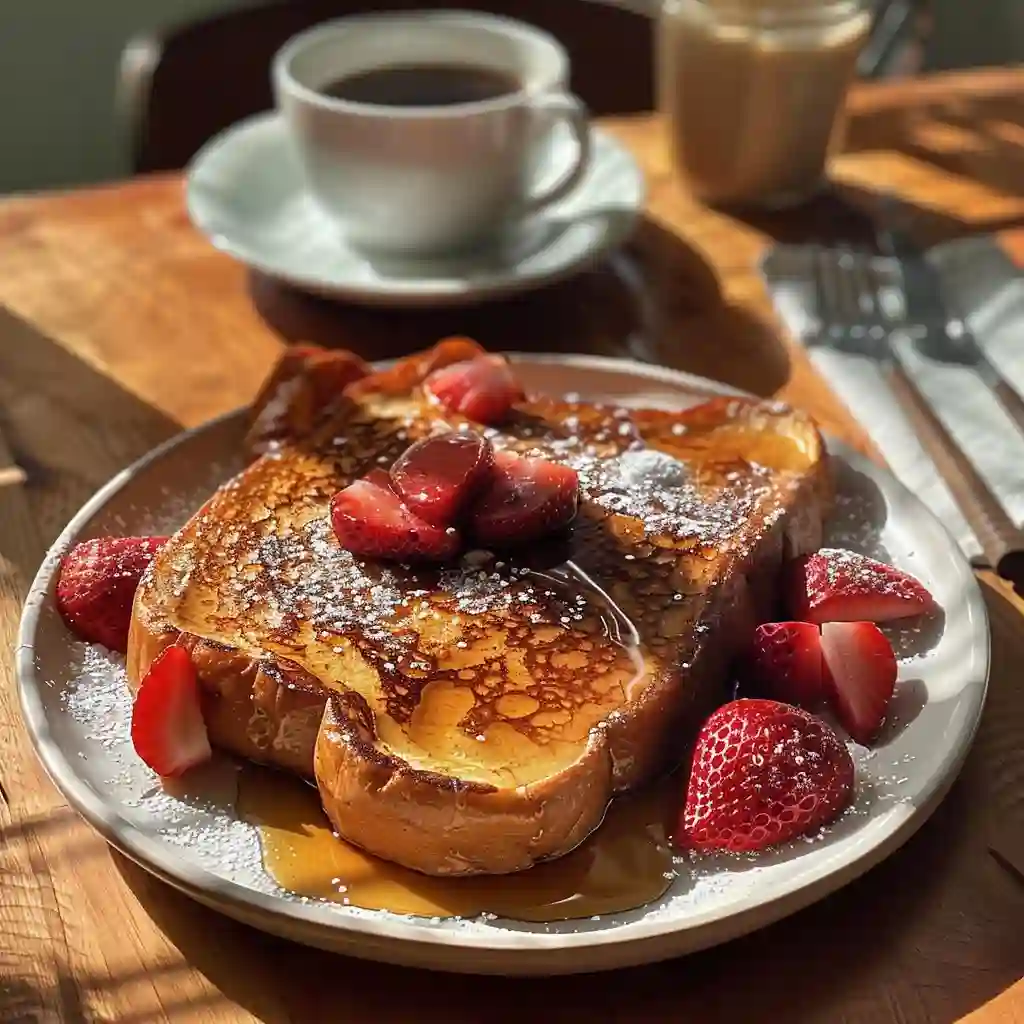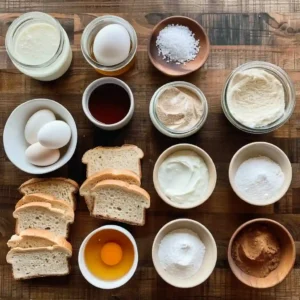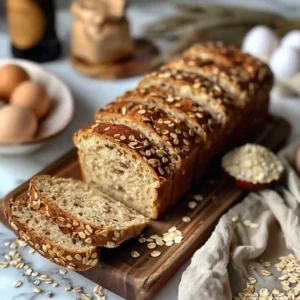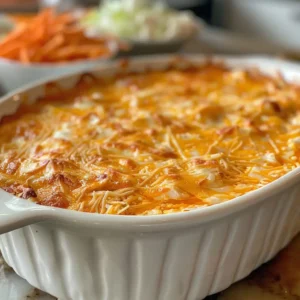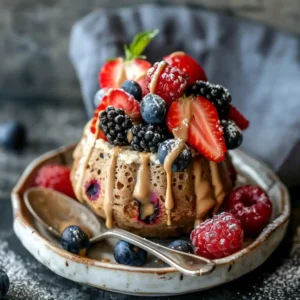High protein French toast has become a breakfast game-changer in my house. As a dad trying to balance energy for work, school lunches, and gym time, I needed something filling, delicious, and protein-packed to keep me going without reaching for snacks by 10 AM. This simple twist on a classic morning favorite delivers that and more—without sacrificing taste or comfort.
In this article, I’ll walk you through everything I’ve learned about crafting the ultimate high protein French toast. We’ll cover the best ingredients for boosting protein, how to balance flavor and nutrition, tips for meal prep, and even some unique variations that my kids now ask for every weekend. You’ll also find ideas for topping it without going overboard on sugar, ways to store leftovers, and a complete FAQ section to answer common questions like: How can you make toast higher in protein? or Is French toast a good source of protein?
Whether you’re hitting your macros, managing weight, or just want something hearty and healthy to start your day, this guide to high protein French toast has you covered.
Quick Answer: How to Make High Protein French Toast
Mix 3 egg whites, 1 whole egg, Greek yogurt, and a scoop of protein powder. Dip high-protein bread into the batter and cook in a non-stick pan until golden. Top with nut butter or Greek yogurt. You’ll get 30–40g of protein and a satisfying, healthy breakfast in minutes.
Table of Contents
Understanding the Basics of High Protein French Toast
What Makes French Toast “High Protein”?
When we talk about high protein French toast, we’re not just tossing eggs onto bread and calling it a day. It’s about choosing smart ingredients that deliver a serious protein punch per serving. Classic French toast relies on eggs and milk, but when you want a breakfast that fuels your body and supports your goals, it’s time to upgrade.
I like to swap in ingredients like high-protein bread, liquid egg whites, Greek yogurt, or even a scoop of protein powder in the batter. These changes turn a comfort food into something you can feel great about eating regularly.
The key? Keep the flavor and texture you love, while layering in more nutrition with every bite.
Why Add More Protein to Breakfast?
From my own experience, boosting my protein in the morning helps me stay full longer, keeps my energy steady, and supports muscle recovery after workouts. Whether I’m rushing to pack school lunches or sneaking in a quick morning run, I rely on breakfasts that work hard for me.
Here’s a quick comparison of how a few swaps can make a big impact:
| Version | Protein (approx.) | Calories |
|---|---|---|
| Classic French Toast (2 slices) | 9g | 300–350 |
| High Protein French Toast | 28g–35g | 350–450 |
The bottom line? With just a few ingredient swaps, high protein French toast becomes more than just a treat—it becomes a smart, satisfying way to fuel your day.
Best Ingredients for High Protein French Toast (Boost Flavor + Macros)
Best Breads for Maximum Protein
Finding the right bread was the first upgrade I made when building my high protein French toast. Regular white or brioche bread tastes great, sure—but they’re light on protein and heavy on simple carbs. I started using high-protein bread, which you can now find in most grocery stores. Look for brands offering 8–12g of protein per slice. Sprouted grain bread or whole wheat protein loaves are great options, and some even include flax or chia for extra fiber.
If you’re gluten-free, you’re not left out. Brands like Carbonaut and others offer gluten-free, high-protein breads too.
Protein-Packed Liquid Options
The batter is where the magic happens. Instead of just using whole eggs and milk, I use a combo of:
- Liquid egg whites (pure protein, no fat)
- One or two whole eggs (for richness)
- Unsweetened almond milk or skim milk
- Plain Greek yogurt (adds creaminess and boosts protein — or swap in cottage cheese for a creative twist)
If I’m going for a 40g protein breakfast, I’ll even blend in a scoop of vanilla protein powder. Just be sure to whisk it well or use a blender to avoid clumps.
This mix tastes just as indulgent as the classic version, especially with a dash of cinnamon, vanilla extract, and a pinch of salt to balance it all out. These swaps are what take your high protein French toast from basic to balanced.
Additional Boosters: Flavors & Nutrition
Here are some other ingredients I rotate into my batter or toppings to upgrade both taste and nutrition:
- Chia or flax seeds – tiny but powerful protein and omega-3 boosters
- Collagen peptides – flavorless and mix well into the batter
- Cottage cheese – blended into the mix or layered on top
- Ground cinnamon + nutmeg – enhances flavor without added sugar
You don’t have to include everything—just pick a few that work for your taste and needs.
When you’re building high protein French toast, think beyond just the macros. The texture and flavor should feel satisfying and comforting, not like a “health food” sacrifice. That’s why choosing quality ingredients makes all the difference in your final result.
Want to see the full step-by-step?
👉 Click here to get the complete recipe now
From batter to bread to boosters, each piece plays a role in creating high protein French toast that’s worth waking up for.
Print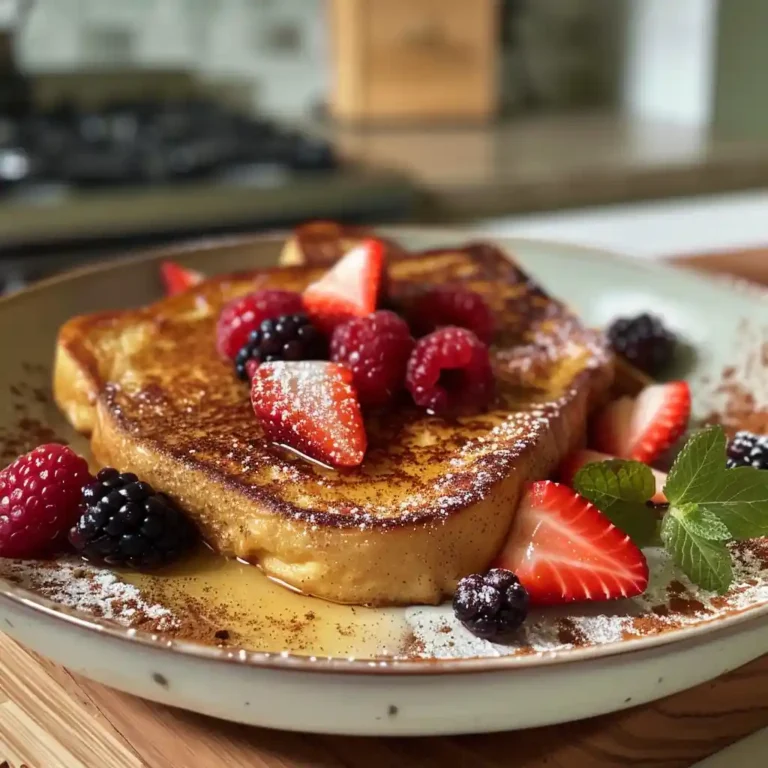
High Protein French Toast (40g Protein, Meal Prep Friendly)
This high protein French toast is fluffy, delicious, and packed with up to 40g of protein per serving. It’s perfect for meal prep, fat loss, or fueling your morning with a healthy twist on a classic.
- Total Time: 20 minutes
- Yield: 2 servings
Ingredients
- 4 slices high-protein bread (8–12g protein each)
- 3 egg whites
- 1 whole egg
- 1/4 cup unsweetened almond milk
- 1/4 cup plain Greek yogurt
- 1 scoop vanilla protein powder
- 1/2 tsp cinnamon
- 1/4 tsp vanilla extract
- Pinch of salt
- Cooking spray
Instructions
- Lay out or toast bread slices to slightly dry them.
- Whisk together egg whites, whole egg, almond milk, Greek yogurt, protein powder, cinnamon, vanilla, and salt.
- Dip each slice of bread in the mixture, soaking for 5–10 seconds per side.
- Heat a non-stick skillet over medium heat and spray lightly with cooking spray.
- Cook each slice for about 3 minutes per side until golden and cooked through.
- Optionally, air fry slices for 30 seconds at 375°F for extra crispiness.
Notes
Serve with high-protein toppings like Greek yogurt, nut butter, or cottage cheese. Sweeten naturally with fruit or a sugar-free syrup. Great for meal prep—freeze and reheat in toaster or air fryer.
- Prep Time: 10 minutes
- Cook Time: 10 minutes
- Category: Breakfast
- Method: Skillet
- Cuisine: American
How to Cook High Protein French Toast Like a Pro
Prepping and Dipping the Bread
Making high protein French toast is simple once you get the hang of the batter. First, make sure your bread isn’t too fresh. Slightly stale bread or toasted slices absorb the batter better without turning soggy. I usually lay out the slices for 10–15 minutes or toast them lightly if I’m short on time.
For the batter, whisk together:
- 3 egg whites
- 1 whole egg
- ¼ cup unsweetened almond milk
- ¼ cup Greek yogurt
- 1 scoop vanilla protein powder
- ½ tsp cinnamon, ¼ tsp vanilla, and a pinch of salt
Dip each slice thoroughly, letting it soak for 5–10 seconds per side. If you’re using thicker bread like sourdough, give it a bit more time.
Cooking Techniques for Texture and Taste
I used to fry my French toast in oil, but I’ve learned that using a non-stick skillet or griddle with a light cooking spray keeps the texture crisp on the outside and tender inside—without the extra calories. Preheat the pan over medium heat, then cook each slice for about 3 minutes per side.
Tips for perfect cooking:
- Avoid overcrowding the pan—give each slice space
- Flip gently once edges start to brown
- Keep a close eye—protein powder browns faster than regular batter
Want to get even crispier edges? Finish each batch with 30 seconds in an air fryer at 375°F.
Smart Topping Choices to Keep It Healthy
High Protein Toppings That Boost Flavor
Toppings can really make your high protein French toast shine. I like to keep things simple, flavorful, and filling. Instead of loading it with sugary syrups or whipped cream, I opt for toppings that offer both taste and nutrition.
Here are some of my go-to high-protein topping ideas:
- Greek yogurt + berries – Creamy and naturally sweet. One scoop of Greek yogurt adds 8–10g of protein.
- Nut butters (like almond or peanut) – A tablespoon gives 3–4g of protein and some healthy fats. I usually drizzle instead of spreading thick.
- Cottage cheese + cinnamon – A surprisingly good combo. Cottage cheese adds a creamy texture and up to 14g of protein per half-cup.
- Protein whipped cream – Made with Greek yogurt, vanilla, and a bit of stevia or honey for sweetness.
- Toasted nuts or seeds – These add crunch and extra protein. I especially love pumpkin seeds or chopped walnuts.
🍫 Looking for something more indulgent? Try this cottage cheese chocolate mousse—it’s high-protein, naturally sweetened, and tastes like dessert.
Sweetness Without the Sugar Crash
If you’ve got a sweet tooth, you can still get that syrupy experience without drowning your toast in sugar.
Better options include:
- Sliced banana or baked apple – Naturally sweet, rich in fiber.
- Maple-flavored sugar-free syrup – Many brands now taste great without added sugar.
- Cinnamon + monk fruit or stevia blend – A warm, low-calorie sweetness.
One trick I use? Mix 1 tsp of peanut butter with protein powder and a splash of almond milk. It turns into a thick, nutty drizzle that’s perfect over high protein French toast.
☕ Want a sweet, filling drink to go with your toast? Check out this Mounjaro high-protein proffee—it pairs perfectly and keeps you full.
By topping your high protein French toast with smart, balanced ingredients, you can enjoy a meal that’s both satisfying and energizing without any sugar crash.
How to Meal Prep High Protein French Toast (Freezer Friendly)
Make-Ahead Options for Busy Mornings
Let’s be real—mornings get hectic. That’s why I started prepping batches of high protein French toast ahead of time. It’s one of the few breakfasts that tastes just as good reheated, especially when you use heartier bread that holds up well.
Here’s how I prep mine:
- Cook 6–8 slices on Sunday.
- Let them cool completely on a wire rack.
- Store them in an airtight container with parchment between slices.
For quick grab-and-go meals, I cut slices in half and freeze them in individual zip bags. That way, I can pull out what I need for the week.
Best Ways to Store and Reheat
- Fridge: Keeps fresh for up to 4 days.
- Freezer: Lasts up to 2 months.
To reheat:
- Microwave: 30–60 seconds for one slice.
- Toaster: Crisps the edges—my favorite way.
- Air fryer: 2–3 minutes at 350°F gives it a freshly-made texture.
Avoid reheating in a skillet unless you use a non-stick surface with minimal spray. Otherwise, the protein-packed batter might stick or dry out.
Bonus tip: If you’re meal prepping for kids, cut the toast into sticks. They love dunking it into Greek yogurt or almond butter like French toast “fries.”
Creative Variations of High Protein French Toast
Savory French Toast Twists
If you’re like me, you eventually get tired of sweet breakfasts every day. That’s when I started experimenting with savory high-protein French toast — and wow, it was a game changer. Instead of vanilla and cinnamon, I use herbs and spices like garlic powder, black pepper, smoked paprika, and a touch of salt in the egg mixture.
My favorite savory combo?
- Egg whites + cottage cheese + spinach blended into the batter
- Topped with sliced avocado and cherry tomatoes
- A sprinkle of feta or shredded chicken breast for extra protein
It’s like a breakfast sandwich without the bread on top — hearty, filling, and packed with flavor.
🍽️ Eating low histamine? Try this low-histamine protein-packed lunch idea — perfect if you want to keep flavors savory and inflammation-friendly.
Dessert-Inspired Options Without the Guilt
You can satisfy your sweet cravings too, but in a way that aligns with your goals. Here are a few dessert-style variations that I’ve made for the kids (and, let’s be honest, for me too):
- Cinnamon Roll French Toast – Add cinnamon and a swirl of protein cream cheese frosting on top (just mix cream cheese, Greek yogurt, and stevia).
- Chocolate Banana Protein Toast – Mix cocoa powder and chocolate whey into your batter, then top with banana slices and a drizzle of almond butter.
- Strawberries and Cream – Add chopped strawberries and sugar-free whipped cream. I usually toss in a few chia seeds for added nutrients.
All of these options keep the protein high while letting you enjoy the cozy, indulgent feel of classic French toast.
🧁 Want more guilt-free dessert inspo? Check out our protein-packed blueberry muffins — they’re perfect for breakfast or snack time.
How to Get 40g of Protein from Your French Toast
Building a 40g Protein Plate
When I first set the goal of getting 40 grams of protein at breakfast, I thought I’d have to eat a mountain of eggs. Turns out, with some smart planning, one serving of high protein French toast can easily hit that target.
Here’s one of my go-to builds:
- 2 slices of high protein bread = 16g
- 3 egg whites + 1 whole egg = 13g
- ¼ cup Greek yogurt in batter = 5g
- 1 tbsp peanut butter = 4g
- 1 tbsp chia seeds = 2g
Total: 40g protein (and it tastes like breakfast heaven)
If I want to boost it further, I blend ½ scoop of vanilla protein powder right into the batter. It adds 10–12g extra protein and gives a dessert-like flavor.
Adding Sides for Extra Protein Punch
Sometimes I mix and match toast with other protein-rich breakfast sides. Here are a few I rotate in:
- Turkey bacon or lean sausage links – 7–10g per serving
- Protein shake on the side – 20g in just a cup
- Cottage cheese parfait with berries – 10–15g depending on the brand
- Hard-boiled eggs – portable and easy
When I combine these with 2–3 slices of protein toast, I stay full for hours—and honestly, I feel more energized and focused through the morning rush.
Is French Toast a Good Protein Source?
Comparing French Toast to Other Breakfast Staples
Let’s clear this up: classic French toast isn’t exactly known as a protein powerhouse—but it can be with a few smart upgrades. When you compare it to standard breakfasts like cereal or pastries, high protein French toast comes out way ahead in terms of nutrition and staying power.
Here’s how it stacks up:
| Breakfast | Protein (approx.) |
|---|---|
| Classic French toast (2 slices) | ~10g |
| High protein French toast | ~30–40g |
| Cereal with milk | ~6–8g |
| Oatmeal with nut butter | ~15–20g |
| Scrambled eggs (3 eggs) | ~18g |
| Protein shake (1 scoop) | ~20g |
When I started swapping out cereal for high protein French toast, I noticed a huge shift. I wasn’t constantly thinking about food by 10 a.m. Plus, it felt like I was treating myself—even though I was fueling my body right.
How to Make Toast Higher in Protein Easily
Here’s a quick checklist I use whenever I want to boost the protein even more:
- Use high protein bread (at least 8g per slice)
- Add Greek yogurt or cottage cheese to the batter
- Mix in 1 scoop of protein powder
- Choose toppings like nut butters or Greek yogurt
- Pair with eggs or a shake if needed
It’s a flexible recipe that works for just about any dietary need—low sugar, high protein, even gluten-free or dairy-free if you choose the right swaps.
How Does High Protein French Toast Compare to Other Breakfasts?
Whether you’re meal prepping for the week, cooking for your family, or just upgrading your own breakfast, high protein French toast gives you a balanced, satisfying start to the day that checks all the boxes: flavor, nutrition, and simplicity.
Frequently Asked Questions About High Protein French Toast
How Do You Increase Protein in French Toast?
Use high-protein bread, egg whites, and Greek yogurt in your batter. Add a scoop of protein powder to boost protein by 10–20g. Toppings like nut butters, seeds, or cottage cheese also help increase total protein without changing the taste.
Is French Toast a Good Protein Source?
Traditional French toast is low in protein, but with a few swaps, it becomes a high-protein meal. Use protein bread, eggs, and Greek yogurt or protein powder. One serving can deliver 25–40g of protein, making it more filling than cereal or pastries.
How Can I Get 40g of Protein for Breakfast?
Here’s a quick build:
2 slices of protein bread = 16g
3 egg whites + 1 egg = 13g
¼ cup Greek yogurt = 5g
1 tbsp peanut butter = 4g
Chia seeds = 2g
Total: ~40g protein
High Protein French Toast Can Change Your Morning Game
Wrapping it all up—high protein French toast has become a staple in my kitchen for good reason. It’s a hearty, versatile, and delicious way to kick off your day with 25 to 40 grams of protein. Whether you’re looking to build muscle, manage your blood sugar, or simply stay full longer, this upgraded version of a breakfast classic delivers big.
What I love most is how customizable it is. You can go sweet or savory, prep it in batches, and make it fit your family’s tastes and goals. From kids to adults, we all get excited when it’s French toast day—and with the protein boost, it’s more than just a treat.
If you haven’t tried making your own, there’s no better time to start. Begin with the simple recipe in Part 1, pick up a few of the toppings and ingredients mentioned, and see how it works for your routine.
Stay fueled, stay full—and enjoy every bite.
This recipe is shared for informational purposes and is not a substitute for medical advice.
Follow me on Facebook and Pinterest for more affordable, healthy family recipes that actually fit into real life.
